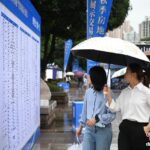“Chongqing explores an integrated approach to micro-renovations to advance the renovation of old districts” is among the 22 innovative practices to be replicated nationwide as listed by the Ministry of Housing and Urban-Rural Development.
On May 29, at a press conference organized by the municipal government titled “Embrace a New Mission, Write a New Chapter”—”City Renewal Action Plan,” it was announced that Chongqing has successfully been selected as one of the first central financial support pilot cities for urban renewal. Currently, many practices from Chongqing have been included in the top-level national policy design, and urban renewal is showing positive momentum.
Cumulative renovation and renewal of 65,000 households in perilous city houses
According to introductions, our city insists on renewal efforts to benefit people and rejuvenate the urban living environment. City-wide, the renovation and renewal of 65,000 households in perilous city houses have been completed. The removal of potential safety hazards in urban-town residential buildings’ exterior walls is planned; by 2024, renewal of gas, sewage, and water supply pipelines will span 4,500 kilometers. Simultaneously promoting the digitalization and intelligent management of underground pipelines will effectively eliminate housing safety, aging networks, and gas leakage risks. Cumulatively, renovation of old urban and colonial districts covered 21 million square meters, advancing 80 city-center village renewal projects, benefiting 220,700 households. Implemented 67 block road renewal projects, completed 61 kilometers of riverside governance, built 817 kilometers of urban hiking trails, and established over 400 kilometers of “clear water green shore” river banks.
Stimulating new urban space vitality, our city adopts the “micro-renovation” model, systematically renewing residential, street, and factory districts, implementing 15 functional quality improvement demonstration projects, achieving through zoned resource integration, project connection, and bundled fund utilization, the organic integration of “scenery at your doorstep” and “income at your doorstep.”
To support high-quality urban renewal development, our city has also formulated the “Chongqing City Central District Urban Renewal Planning.” Combining the urban layout of central districts, forming a “point-line-plane” renewal space structure, identifying 328 key renewal areas in old districts, old commercial districts, old factory districts, and old streets—covering an area of 137 square kilometers. Integrating 134 renewal zones, promoting functional renewal, protective renewal, and safeguard renewal in categories.
Pioneering full coverage of three-level elderly care service networks
Currently, the elderly population in old districts in Chongqing’s central district exceeds 30%, significantly higher than the city’s overall 24% average. To allow the elderly to enjoy a happier late life, our city’s civil affairs department, with the target of building a “15-minute elderly service circle,” has mainly launched three major actions.
At the urban-town level, implementing three-level elderly care service system construction actions, establishing 52 district centralized care centers for the incapacitated and severely disabled, 220 street elderly service centers, and 2,871 community elderly service stations, pioneering basic full coverage of the three-level elderly care service network in the western and central regions.
At the community level, launched idle asset revitalization actions, combining “Three Strongholds, One Revitalization” reforms, systematically utilizing 67.8 million square meters of idle community storefronts and kindergartens, building community elderly service complexes, elder dining halls, and university for the elderly as aged care facilities, allowing the elderly to conveniently access care nearby.
At the household level, carrying out residential elderly-friendly transformations, providing over 40,000 elderly families with safety equipment such as handrails, grab bars, bath seats, and household health monitoring devices, fall prevention response installations, emergency call devices as tech products, offering home care services for over 8,000 immobile elderly, cultivating safe, comfortable, barrier-free living environments.
This year, launching 1,227 old district renewal projects
As a key livelihood project, renewal of old districts has been listed as a Chongqing key livelihood fact for five consecutive years. Last year, the city added 2,620 new projects for the renewal of old districts, benefiting directly over 570,000 households; this year, our city is launching another 1,227 renewal projects for old districts, allowing even more residents to enjoy practical benefits.
During the urban-town old district renovation process, Chongqing avoids a “one-size-fits-all” approach, but formulates separate renewal plans for each neighborhood with “customization” strategies to precisely solve pain points. To date, the city has renovated and rectified 17.05 million square meters of exterior walls, added over 63,000 new parking spots, added 940,000 square meters of activity areas, and renovated 57.62 million kilometers of water, electricity, and gas pipelines, completed installation of 6,752 elevators, upgraded over 10,000 service facilities like “One Senior One Child,” agricultural market supermarkets, public health convenience facilities, solving a batch of short board and pain point problems.
Our city uses “participative” renovation to stimulate activation from various sides. Before renovation, the municipal housing and urban-rural development commission collects residents’ opinions online and offline, promotes planners, architects, and engineers to guide resident participation in neighborhoods, jointly discussing renovation content; during renovation, fully exerts the role of financial funds as leverage, pushes Community main bodies to participate in operational asset construction according to who benefits, who funds the principle, guiding residents through direct investments, using substantial repair funds, sharing public revenue methods to reasonably implement financial responsibility; post-renovation, organizing residents to independently select management models and conduct reviews of renovation work. Through the entire process of “common negotiation, construction, management, and sharing,” the old district renovation process is well-achieved. (Xinhua – Chongqing Daily reporter Liu Xuemei)



